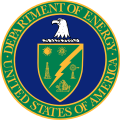United States Secretary of Energy
The United States Secretary of Energy is the head of the United States Department of Energy, a member of the President's Cabinet, and fifteenth in the Presidential line of succession. The post was created with the formation of the Department of Energy on October 1, 1977 by President Jimmy Carter's signing of the Department of Energy Organization Act.[2] The position was originally developed to focus on energy production and regulation. During the 1980s, the emphasis shifted to development of technology for better, more efficient energy sources as well as education regarding energy. As the Cold War ended, the department's efforts were more often devoted to nuclear waste disposal and maintenance of environmental quality.[3]
| United States Secretary of Energy | |
|---|---|
 Seal of the Department | |
 Flag of the Secretary | |
| United States Department of Energy | |
| Style | Madam Secretary (informal) The Honorable (formal) |
| Member of | Cabinet National Security Council |
| Reports to | President of the United States |
| Seat | James V. Forrestal Building, Washington, D.C. |
| Appointer | The President with Senate advice and consent |
| Term length | No fixed term |
| Constituting instrument | 42 U.S.C. § 7131 |
| Formation | August 6, 1977 |
| First holder | James R. Schlesinger |
| Succession | Fifteenth[1] |
| Deputy | Deputy Secretary of Energy |
| Salary | Executive Schedule, level I |
| Website | Energy.gov |
List of Secretaries of Energy
change- Parties
Democratic (7) Republican (9)
Status
Acting Secretary of Energy
Reported Nominee for Secretary of Energy
| No. | Portrait | Name | State of residence | Took office | Left office | Party | President(s) | |
|---|---|---|---|---|---|---|---|---|
| 1 | James Schlesinger | Virginia | August 6, 1977 | August 23, 1979 | Republican | Jimmy Carter | ||
| 2 | Charles Duncan | Texas | August 24, 1979 | January 20, 1981 | Democratic | |||
| 3 | James Edwards | South Carolina | January 23, 1981 | November 5, 1982 | Republican | Ronald Reagan | ||
| 4 | Donald Hodel | Oregon | November 5, 1982 | February 7, 1985 | Republican | |||
| 5 | John Herrington | California | February 7, 1985 | January 20, 1989 | Republican | |||
| 6 | James Watkins | California | March 1, 1989 | January 20, 1993 | Republican | George H. W. Bush | ||
| 7 | Hazel O'Leary | Virginia | January 22, 1993 | January 20, 1997 | Democratic | Bill Clinton | ||
| 8 | Federico Peña | Colorado | March 12, 1997 | June 30, 1998 | Democratic | |||
| 9 | Bill Richardson | New Mexico | August 18, 1998 | January 20, 2001 | Democratic | |||
| 10 | Spencer Abraham | Michigan | January 20, 2001 | February 1, 2005 | Republican | George W. Bush | ||
| 11 | Samuel Bodman | Illinois | February 1, 2005 | January 20, 2009 | Republican | |||
| 12 | Steven Chu | California | January 20, 2009 | April 22, 2013 | Democratic | Barack Obama | ||
| – | Daniel Poneman | Ohio | April 22, 2013 | May 21, 2013 | Democratic | |||
| 13 | Ernest Moniz | Massachusetts | May 21, 2013 | January 20, 2017 | Democratic | |||
| – | Grace Bochenek | January 20, 2017 | March 2, 2017 | Donald Trump | ||||
| 14 | Rick Perry | Texas | March 2, 2017 | December 1, 2019 | Republican | |||
| 15 | Dan Brouillette | Texas | December 1, 2019 | December 4, 2019 | Republican | |||
| December 4, 2019 | January 20, 2021 | |||||||
| – | David Huizenga | January 20, 2021 | February 25, 2021 | Democratic | Joe Biden | |||
| 16 | Jennifer Granholm | Michigan | February 25, 2021 | — | Democratic | |||
| nominee | Chris Wright | Colorado | Republican | Donald Trump | ||||
References
change- ↑ "3 U.S. Code § 19 - Vacancy in offices of both President and Vice President; officers eligible to act | US Law | LII / Legal Information Institute". Law.cornell.edu. Retrieved June 14, 2017.
- ↑ "Origins". Department of Energy. Archived from the original on 2007-02-10. Retrieved 2007-07-29.
- ↑ "The Clinton Administration". Washington Post. Retrieved 2007-07-29.
